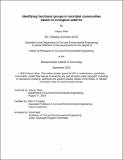Identifying functional groups in microbial communities based on ecological patterns
Author(s)
Shan, Xiaoyu
DownloadThesis PDF (3.681Mb)
Advisor
Cordero, Otto X.
Terms of use
Metadata
Show full item recordAbstract
Recent development in sequencing technologies has greatly advanced our understandings of structure and function of microbial communities in various ecosystems. In microbial communities, a metabolic function is often performed by a group of multiple species (i.e., a functional group) at the same time. However, identifying these functional groups remains to be a major challenge for structure-function mapping in microbiome studies. Instead of relying on annotation-based methods that are highly biased for a few model microorganisms, here I tackle this challenge by developing a novel annotation-free approach. In chapter two, I develop the mathematical framework behind the new approach – which we call EQO – and show its power by applying it to a few existing microbiome datasets. I show that, based solely on the patterns of statistical variation in species abundances, EQO identifies functional groups in soil, ocean and animal gut microbiome. The following two chapters discuss an application of this method, which has led to the discovery a potential new form of interaction between bacteria in animal guts, and an unexpected finding in the lab regarding the ecological dynamics of phage-plasmids in marine bacterial populations. In chapter three, I show how applying EQO to an aquaculture dataset leads us to identify potential pathogen-inhibiting groups of bacteria in an animal-associated microbiome. Guided by the computational prediction, I successfully isolate a member of this group that is a novel species with a broad spectrum of interaction against various Vibrio pathogens. By synthesizing and secreting polysaccharides, the novel species causes limited dispersion and reduced virulence of Vibrio. My efforts to understand the ecology of marine bacteria also lead me to study the role of widely distributed phage-plasmids. Combining mathematical models and experimental evidence, I show that loss-of-function mutations and segregational drift recurrently drive productive infections of phage-plasmids within marine bacterial populations. Together, this thesis provides a simple yet powerful approach to abstract functional groups from taxonomic composition in complex microbiome. As a useful hypothesis generating tool, this approach will pave the way for more mechanistic studies of microbiome in the future.
Date issued
2023-09Department
Massachusetts Institute of Technology. Department of Civil and Environmental EngineeringPublisher
Massachusetts Institute of Technology